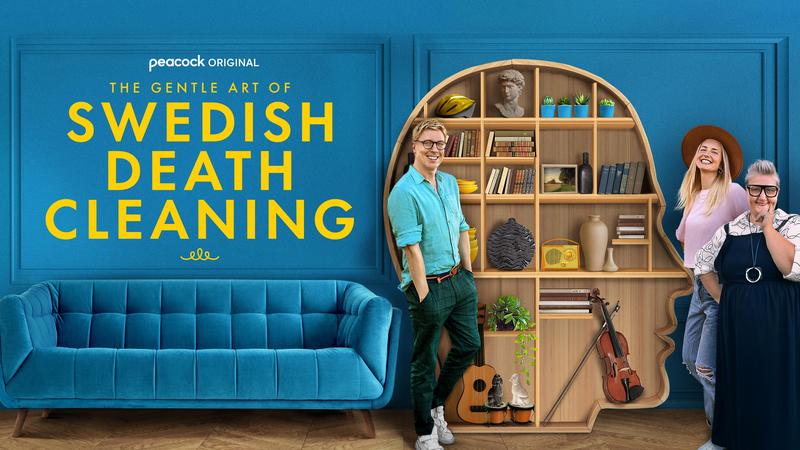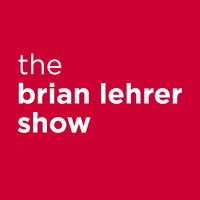What 'Swedish Death Cleaning' Is and Why You Should Do It

( Peacock / Courtesy of )
[MUSIC ]
Brian Lehrer: Brian Lehrer on WNYC. Now, if I told you you're about to meet three Swedish death cleaners, would you be scared or would you welcome them? If the phrase conjures up a man all in black from an Ingmar Bergman movie, you're pretty far off. I'm being joined by the stars of the new show on Peacock called The Gentle Art of Swedish Death Cleaning, which is based on the 2018 book of that title by Margareta Magnusson. It's not about death so much as about freeing yourself to enjoy the here and now and at the same time not leaving a mess behind. Here I will let her explain from the show's trailer 11 seconds.
Amy Poehler: They all need the gentle art of Swedish death cleaning. What is Swedish death cleaning, you say? Basically cleaning out your craft so that others don't have to do it when you're gone.
Brian Lehrer: Yes, that was Amy Poehler, for those of you who heard that voice and said, "Wait, is that Amy Poehler?" She narrates the series and is an executive producer of the show. With that, I will welcome the death cleaners, psychologist Katarina Blom, organizer Ella Engström, and designer Johan Svenson. Hello, all of you, and welcome to WNYC.
Johan Svenson: Hi, thank you for inviting us.
Katarina Blom: Thank you.
Johan Svenson: Thank you.
Brian Lehrer: Let's introduce people who haven't seen the show to the concept. Katarina Blom, is this a widely known process in Sweden?
Katarina Blom: Yes, it is. It's deeply rooted in our culture. My mother talked about death cleaning when she was growing up, as did I. It's something everybody knows, but we don't even talk about it that often. We just do it.
Brian Lehrer: The fact that you're a team tells us this is not just about decluttering, but is that where it starts? Let me ask the organizer Ella Engström. Ella?
Ella Engström: Yes. What was the question? Sorry, I didn't hear it.
Brian Lehrer: Well, it starts with decluttering but goes beyond that.
Ella Engström: Yes, it does. It's about really founding out what first you're here and now in your life and also have the things that also goes hand in hand with that so you don't have a lot of stuff that holds you stuck.
Brian Lehrer: For example, tell us a story. You got one?
Ella Engström: Yes, we have a lot of people we met in the show that were stuck in the past as well, because, for example, we had a man that had lost his wife over 10 years ago, and he had the whole basement full of stuff, and some of the stuff were her things as well. He had a new fiance and he wouldn't move in with him because he hadn't dealt with all these things in the basement. That's one example how it can be.
Brian Lehrer: Johan Svenson, does the design, and you're a designer, and people may think, well, what is a designer doing in a conversation about cleaning out your stuff before you?
Johan Svenson: [laughs] About that.
Brian Lehrer: That's when design is not supposed to matter anymore. Why are you, as a designer, part of this trio?
Johan Svenson: Because I matter. No. In the show we're actually not dealing with people who has passed or families. We're dealing with the belongings of someone who actually has passed. We're actually talking to people who live here and now very much alive. The design process is a lot about after Ella been sorting out their stuff, editing it. It's about actually creating a space that is livable and also, in a way, reflects the way you want to live your life. It's not just about the design or the aesthetics of it. It's about how is the space going to be, how is the space going to serve you? There's a lot of interesting psychological part on how the design actually reflects you and the way you live. Do you get me?
Brian Lehrer: I think so, yes. You're saying the design element helps people see the reward of all that decluttering, not just the burden of it.
Johan Svenson: Exactly. It goes a bit hand in hand, actually. When we've actually gone through someone's house, home, edited the stuff, thrown things away, donated things, or also maybe upscaled something, that's when I come in and also do this spatial design of it to refresh your house a bit. It's also in a close conversation to the participant in the show.
Brian Lehrer: Listeners, have you read the book or seen any of the episodes of the series on Peacock and given death cleaning, as it's called, a try? Swedish death cleaning, or maybe there's a US version of it, we'll ask our guests that. Share your experience or get some pointers from our guests, or ask any question at 212-433-WNYC, 212-433-9692. Or you can text a question to that number. Katarina, I think that the book was aimed at empty nesters who want to get things straightened out before it's too late, but the TV show widens the scope and helps people at that stage of life. Yes, but also younger people who maybe have a basement full of stuff from their parents or their kids.
Katarina Blom: Absolutely.
Brian Lehrer: When is this death cleaning needed?
Katarina Blom: It's actually any day. You could start death cleaning today because we don't know when we're going to die. We could all die tomorrow, and do we really want to leave our house, our apartment, our home, the way it looks exactly right now? Probably not, and as Ella often says, when you live a life, you go through different stages and your needs change, so it's good to pause and reflect, is my home really reflecting my current needs? Am I proud over the way I live my life moving forward?
A lot of these people that we met were stuck in the past and all of them needed some lift in their life. In each episode, you can really see how the things and the emotions go very well hand in hand. When we declutter, they also start to declutter their soul, as one of the participants said.
Brian Lehrer: Yes, and that's why, I guess, when you talk about people being stuck in the past, you as a psychologist are even involved here, because, again, to reset the three of you as central figures in this series a designer, an organizer, and you a psychologist, we could make the beginning of a joke out of this. An organizer, a designer, a psychologist walk into a bar or walk onto a streaming platform, but what do you find are some of the biggest psychological questions, Katarina, to stay with you for another question?
Katarina Blom: Yes, sure. I think the biggest thing is really human. We all have our own version of this. We avoid pain at all costs because it's very unpleasant to be in contact with pain, but sometimes avoiding pain comes at a cost. That cost can be that you feel stuck in life, that you don't feel alive anymore, that you're wondering why I'm struggling with finding new relationships or finding joy in my everyday life.
What I mainly did, and all three of us actually, was taking the person in their hand and carefully, gently moving towards what's really painful. What is it that you are avoiding and that's keeping you a prisoner of your past? All of our participants were so brave. They really did this journey full-on. Open eyes, clear hearts. It was amazing to be a part of it.
Brian Lehrer: I think we've got a fan of your show here. Ben on the Upper West Side, you're on WNYC. Hello.
Ben: Hi, Brian. First, I'm one of the millions that think you're a national treasure. I rarely get to hear your show live because I'm a musician, I'm usually practicing, and I just heard this. I want to tell your guest, my wife and I absolutely adore your show. It's very profound, and it's influenced me. If you could only see my studio filled with books and music and guitars. Thank you for this show. I recommend everybody watch this show.
Brian Lehrer: Are you mostly getting entertained by it then, or are you getting some life tips?
Ben: No, life tips, definitely. Especially as I clutter and I'm getting my wife and I are talking about moving, and so we really have to think about, "Hey, you don't need this." I have to say, our son is very [unintelligible 00:09:22] he says, "You haven't looked at this in six years. Or as a musician, I have so much music and CDs that I don't listen to anymore. No, it's actually influenced me directly.
Katarina Blom: Wow.
Ben: Yes, it's really [inaudible 00:09:36] their interaction. They're also hilarious. All of you guys are. I don't know which one I love more. You really are. You're just the best, but it's very profound, and they really move people. Everybody should watch it, especially because we all have- those of us that are lucky enough have too much stuff.
Brian Lehrer: Just another comedy about death and decluttering. Ella, let me go to you on this, and I think our line is not great. We have a better connection with your partners. Ben brought that up about working with his parents on this. We have a text from a listener who says, "I am struggling to communicate this concept to my parents who badly need to downsize." I wonder about the etiquette of that and the ethics of that because you're winding up confronting maybe an elderly parent with their mortality if you go straight there.
Ella Engström: Yes. It's a lot of just taking the time and sit together. Of course, you need to build up that conversation. You don't just jump into it directly. I think if you look around in the home and see where it's full, where you have those piles ending up [chuckles] and what kind of items are in those piles, and just start there and see if you can get rid of a little of things, and just also figure out what is the important stuff. To take that conversation from that term, I think it's important to see, so it doesn't get lost with all the other things that you have.
Brian Lehrer: Roseann on Staten Island has a particular death cleaning- what's the word- tip, I guess, that she wants. Roseann, you're on WNYC, hello.
Roseann: Yes. Hello, Brian, first time caller, and I love your show.
Brian Lehrer: Thank you.
Roseann: Yes, I have thousands, and I mean, thousands slides, regular photos from 1940s maybe 19' early 2000s from my parents. I don't know what to do with them. They're all over the place in boxes and tubs, taking my basement over. My daughter [chuckles] does not want to help me, so I'm at a loss.
[laughter]
Brian Lehrer: A whole lifetime of physical printed photos. Ella, I'll go back to you on this as the organizer in the group.
Ella Engström: Yes. The question is, do you know which people are even in these photos? If you don't know that, maybe it's nothing, not so much to save either. Start with that and take it down bit by bit and do a little now and then. Take one [unintelligible 00:12:43] box a day or something. That's the tip, so you don't do the whole thing at the whole time because then, it's very easy to get overwhelmed when you're doing these kind of things, so divide it.
Brian Lehrer: Yes. Katarina, for you as a psychologist, I'll bet that's a psychological hurdle, throwing out old photos, especially if you do know who's in the photos, but you just have too many of them.
Katarina Blom: Yes. I would say you can probably get rid of much more than your emotions tell you because we have this natural-- it doesn't have to be, but we often feel a bit guilty of getting rid of our parents' things. We actually had this in one of the episodes. She had a lot of things from her mother. She kept everything, but she felt super guilty about even thinking about getting rid of these things, even though she hated them. I really think you should start, just like Ella said, this is about exposure to unpleasant emotions like guilt. Just go at it, start doing it, and I bet that you don't need to save a lot of those photos.
Go by the pictures. If you know people is a great tip but definitely, don't listen too much to your emotions when you go through this. This is more about pushing through, I would say.
Brian Lehrer: For you, Johan, on the design side, do you have any tricks or favorite methods for finding your balance between honoring the lives and sacrifices of those who came before you against the weight that that can be to carry?
Johan Svenson: In a way, yes, because one of the takeaways from the show is that The Gentle Art of Swedish Death Cleaning is about a philosophy and a process that you start. It's not a quick fix. It's not something that you do over a day or even a week or a month. It's about a philosophy on how you look at life and the legacy you have and how you edit it. I think when you also read a book, see the TV series, you will understand that this process is something, it's a way of a mindset that you will know, so you will have the answers yourself.
Brian Lehrer: Yes. Another answer to Roseann's question, I think on the old photos is the cloud. If you can digitize them, put them into the cloud, then they don't take up any physical space, that, of course, is a whole project. For older people who may not know how to do that, you can also bring it into places that will do it for you.
Johan Svenson: We're also in a time when all of these things are overlapping because we have the digital age and some people who have never seen or handled a physical copy of an image. I think sometimes it's easier today to handle physical copies because today people take so many images on their phones.
Brian Lehrer: That's right.
Johan Svenson: Their clouds are [unintelligible 00:15:47].I think in one of the episodes with Stu, she's an artist and she had beautiful images from a lesbian community in Kansas City. What I showed her was also when you have stacks and piles of photos, that you can actually determine different types of quality depending on when they were printed, so you can start actually easily to sort all the images that you have in boxes. You can see that this is taken on the '90s, this is in the '20s, and then you go down and group them depending on theme.
Brian Lehrer: I will admit though, it's actually on my to-do list to declutter my cloud photo file.
[laughter]
Brian Lehrer: For some folks, one day when you pass, you may leave a monthly storage charge [chuckles] to your kids depending on how much storage space you use. Leslie on Syosset, you're on WNYC. Leslie, we've got about 30 seconds for you. Hi.
Leslie: Hi. My mother invented this. About 10 years ago, she said to me, "I want to clear out everything to not leave a mess. I want to have the joy of seeing people receive my possessions." My mother died seven months ago, and we're actually doing this now. I'm actually doing it for myself. What scared me when I read the review in the paper of the book is that my mother is half Swedish but did not grow up in the culture. It just came right out of her bones.
Brian Lehrer: Huh?
[laughter]
Leslie: She said, "I want to do this."
Katarina Blom: Wow.
Brian Lehrer: That is probably a good point on which to leave it. All eight episodes of The Gentle Art of Swedish Death Cleaning are available on Peacock-
Johan Svenson: They are.
Brian Lehrer: -which is NBC's streaming service. We thank you to the Death Cleaning trio, psychologist, Katarina Blom, organizer, Ella Engström, and designer Johan Svenson. Johan, you want to take a 15-second last word and say, are you planning a second season?
Johan Svenson: Well, we hope to. We're actually going to go out on Bravo TV in July, so we'll reach a lot of more people during that time. Let's see what happens. We're curious about how the Americans perceive this show, and so far so good.
[MUSIC -- Soulive: Solid]
Brian Lehrer: Thank you all for joining us today. We really appreciate it.
Katarina Blom: Thank you.
Ella Engström: Thank you.
Brian Lehrer: That's The Brian Lehrer Show for today. Produced by Mary Croke, Lisa Allison, Amina Srna, Carl Boisrond, and Esperanza Rosenbaum. Zach Gottehrer-Cohen produces our daily podcast. We had Shayna Sengstock at the audio control. Stay tuned for Allison.
Copyright © 2023 New York Public Radio. All rights reserved. Visit our website terms of use at www.wnyc.org for further information.
New York Public Radio transcripts are created on a rush deadline, often by contractors. This text may not be in its final form and may be updated or revised in the future. Accuracy and availability may vary. The authoritative record of New York Public Radio’s programming is the audio record.

